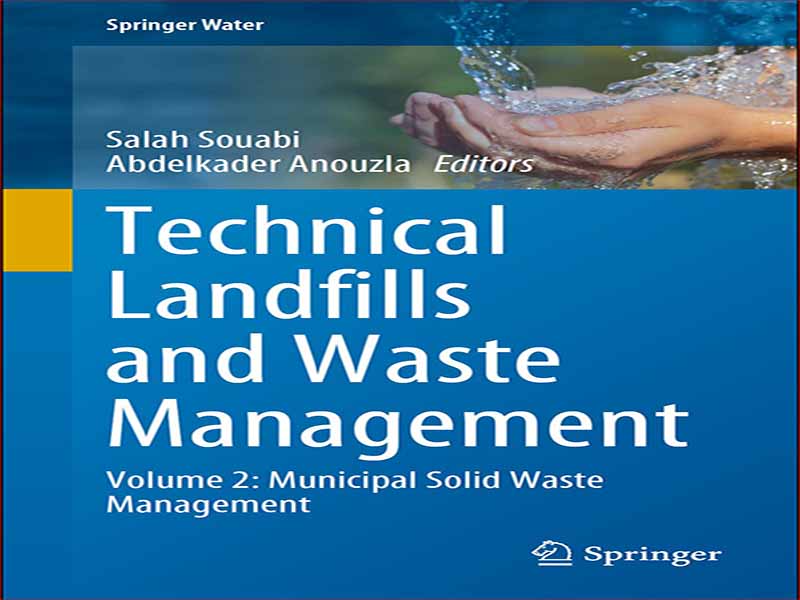- عنوان کتاب: Technical Landfills and Waste Management – Volume 2: Municipal Solid Waste Management
- نویسنده: Abdelkader Anouzla
- حوزه: پسماند
- سال انتشار: 2024
- تعداد صفحه: 322
- زبان اصلی: انگلیسی
- نوع فایل: pdf
- حجم فایل: 9.55 مگابایت
اصطلاح “ضایعات جامد” همانطور که توسط قانون حفظ و بازیابی منابع (RCRA) تعریف شده است به هرگونه مواد دور ریخته شده، مانند زباله یا زباله، لجن از تصفیه خانه های آب و فاضلاب، یا گازهای گلخانه ای از تاسیسات کنترل آلودگی هوا، که ناشی از انواع مختلف است، اطلاق می شود. فعالیت های صنعتی، تجاری، معدنی، کشاورزی و اجتماعی. بسیار مهم است که تاکید شود که تعریف زباله جامد به حالت جامد فیزیکی محدود نمی شود، زیرا بسیاری از زباله های جامد می توانند به شکل مایع، نیمه جامد یا گاز باشند. علاوه بر این، زبالههای جامد شهری (MSW)، که معمولاً به عنوان زباله یا زباله شناخته میشود، در ابتدا شامل تمام زبالههای دور ریختنی در مناطق شهری میشود و ممکن است شامل طیف گستردهای از اقلام، از جمله بستهبندی محصول، بریدههای چمن، مبلمان، لباس، بطریها، ضایعات مواد غذایی باشد. روزنامه ها، لوازم خانگی و باتری.
سیستم مدیریت کامل زباله معمولاً شامل چهار مرحله کلیدی است: تولید زباله، جمعآوری و حمل و نقل، تصفیه فیزیکی/بیولوژیکی/حرارتی و دفن زباله. هر یک از این مراحل نقش مهمی در مدیریت موثر زباله های جامد ایفا می کند. هنگام ارزیابی و انتخاب مناسب ترین گزینه برای هر یک از این مراحل در یک سیستم جامع مدیریت پسماند، توجه به عوامل مختلف محیطی، اقتصادی، اجتماعی و سیاسی ضروری است. این ارزیابی کامل تضمین می کند که رویکرد مدیریت پسماند انتخاب شده با اهداف کلی توسعه پایدار و حفاظت از محیط زیست مطابقت دارد. علاوه بر این، شناسایی خصوصیات فیزیکی، شیمیایی و بیولوژیکی جریان زباله در طول فرآیند انتخاب ضروری است. این اطلاعات بینشهای ارزشمندی در مورد ماهیت زبالهها ارائه میکند و به تعیین مناسبترین روشهای تصفیه یا دفع کمک میکند.
در نتیجه، زباله های جامد، همانطور که RCRA تشریح می کند، طیف گسترده ای از مواد و محصولات جانبی تولید شده از فعالیت های مختلف انسانی را در بر می گیرد. مدیریت پسماند جامد مستلزم رویکردی جامع است که نه تنها شکل فیزیکی پسماند، بلکه تأثیر زیست محیطی و پتانسیل آن برای بازیابی منابع را نیز در نظر بگیرد. بنابراین، ارزیابی مستمر و بهبود شیوه های مدیریت پسماند برای به حداقل رساندن آلودگی محیط زیست و ترویج توسعه پایدار بسیار مهم است. این کتاب مطالعهای را ارائه میکند که در چندین فصل، مشکلات زباله جامد در سایتهای فنی دفن زباله را شناسایی میکند، که مبنایی ضروری برای تصمیمگیری، بهویژه برای ترسیم خط مشی مدیریت پسماند جامد است. ثابت میکند که معرفی، تطبیق و توسعه فناوری جدید برای مدیریت صحیح مجموعههای مرتبسازی بالادست و پایین دست، کمکی عالی در تضمین مدیریت ایمن و کاهش روند گرمایش جهانی با به حداقل رساندن اثرات زیستمحیطی است. در واقع، برخی از فصول بر ارزیابی پتانسیل آلاینده این زباله ها بر روی محیط زیست، خاک، آب های سطحی، آب های زیرزمینی و غیره تمرکز داشتند. در سرتاسر جهان، چندین واحد تولیدی (مزارع، تعاونی ها، صنایع کشاورزی و غذایی و غیره) مقادیر زیادی پسماندهای آلی و پسماند تولید می کنند و به دنبال راه های بهتری برای بازیافت آنها هستند. این زباله ها اغلب در مکان های دفن زباله ته نشین می شوند که به طور قابل توجهی بر محیط زیست تأثیر می گذارد. این مطالعه مهندسی (ارزیابی تأثیر پسماند جامد بر محیط زیست) برای مدیریت صحیح پسماندهای جامد در بالادست و پایین دست می تواند برای پیشگیری و آگاهی تصمیم گیران و متخصصان در جهت کاهش آلودگی برای حفظ سلامت افراد ضروری باشد. جمعیت و در نتیجه حفاظت از محیط زیست. علاوه بر این، مهندس آموزش دیده باید اصول اساسی را بهتر درک کند و از شباهت ها برای پیشنهاد برنامه های اقدام برای به حداقل رساندن مشکلات آلودگی زیست محیطی آگاهی بیشتری داشته باشد.
جهان به سمت یک اقتصاد دایره ای در حال تکامل است که بر کاهش ضایعات و افزایش عمر مفید کالاها تاکید دارد.
The term “Solid Waste” as defined by the Resource Conservation and Recovery Act (RCRA) refers to any discarded material, such as garbage or refuse, sludge from water and wastewater treatment plants, or emissions from air pollution control facilities, that results from various industrial, commercial, mining, agricultural, and community activities. It is crucial to emphasize that the definition of solid waste is not confined to the physical solid state, as many solid wastes can be in liquid, semi-solid, or gaseous form. Moreover, Municipal Solid Waste (MSW), commonly referred to as trash or garbage, initially encompassed all discards in urban areas and may consist of a wide range of items, including product packaging, grass clippings, furniture, clothing, bottles, food scraps, newspapers, appliances, and batteries.
The complete waste management system typically includes four key stages: waste generation, collection and transportation, physical/biological/thermal treatment, and landfilling. Each of these stages plays a crucial role in managing solid waste effec-tively. When evaluating and selecting the most appropriate option for any of these stages within a comprehensive waste management system, it is essential to consider various environmental, economic, social, and political factors. This thorough eval-uation ensures that the chosen waste management approach aligns with the overall goals of sustainable development and environmental protection. Furthermore, the identification of the physical, chemical, and biological characteristics of the waste stream is imperative during the selection process. This information provides valu-able insights into the nature of the waste and aids in determining the most suitable treatment or disposal methods.
In conclusion, solid waste, as the RCRA outlines, encompasses a broad spec-trum of materials and by-products generated from diverse human activities. The management of solid waste requires a comprehensive approach that considers not only the physical form of the waste but also its environmental impact and potential for resource recovery. Therefore, it is crucial to continuously evaluate and improve waste management practices to minimize environmental pollution and promote sustainable development. This book presents a study that identifies, in several chapters, the problems of solid waste at technical landfill sites, which constitute a necessary basis for decision-making, especially for outlining solid waste management policy. Proves that intro-ducing, adapting, and developing new technology for properly managing upstream and downstream sorting collection constitutes an excellent contribution to ensuring safe management and mitigating the trend toward global warming by minimizing the environmental impact. Indeed, some of the chapters focused on assessing the polluting potential of this waste on the environment, soil, surface water, ground-water, etc. Around the world, several production units (farms, cooperatives, agri-food industries, etc.) face vast quantities of organic residues and waste and are looking for better ways to recycle them. This waste is often deposited in landfill sites, which considerably impacts the environment. This study of engineering (assessment of the impact of solid waste on the environment) for the proper management of solid waste upstream and downstream could be necessary for the prevention and awareness of decision-makers and specialists for the reduction of pollution to protect the health of the population and subsequently the protection of the environment. In addition, the trained engineer should better understand the fundamental principles and be more aware of the similarities for proposing action plans to minimize environmental pollution problems.
The world is evolving toward a circular economy, which emphasizes lowering waste and extending the useful life of commodities.
این کتاب را میتوانید از لینک زیر بصورت رایگان دانلود کنید:
Download: Technical Landfills and Waste Management



































نظرات کاربران